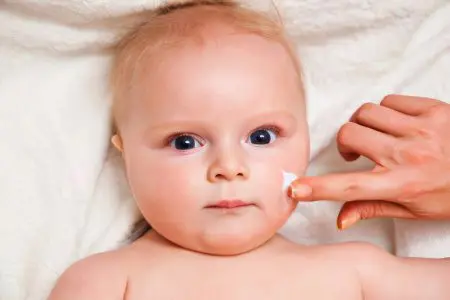Contents

Diathesis is a hereditary predisposition of a child to various allergic reactions, respiratory infections, impaired acid-base metabolism, etc.
If we turn to the Greek language, then the word “diathesis” is translated as “inclination”. Modern medicine does not consider diathesis as some kind of disease. It is equated with special conditions that develop in childhood.
The main characteristics of this violation:
Diathesis has a hereditary predisposition.
It is characterized by an undulating course. From time to time there are exacerbations of diathesis.
Diathesis often develops in children who suffer from allergies, SARS, seizures, metabolic disorders, immunological pathologies.
A favorite place for the manifestation of diathesis are children’s cheeks.
Diathesis reasons

It is difficult to confine ourselves to one reason why a child develops diathesis. As a rule, it is a whole complex of factors. Together, they provoke this violation.
These include:
Hereditary predisposition.
Serious errors in the diet of a pregnant woman: eating harmful foods that are replete with chemical components.
Excess consumption of allergenic foods during pregnancy. Such products are: honey, berries, chocolate, citrus fruits, nuts, milk, eggs.
Chronic diseases of a woman, as well as infectious diseases transferred during pregnancy.
Treatment with antibacterial drugs during gestation.
Severe toxicosis during pregnancy.
Feeding the baby with artificial mixtures, or too early refusal of breastfeeding.
Allergy of the child to artificial mixtures or to cow’s milk. Too early its introduction into the diet of the baby.
Diathesis can be triggered by food allergies, skin contact with allergenic substances, their inhalation.
Respiratory diathesis

Respiratory diathesis may be due to the following factors:
Lack of wet cleaning in the room where the baby lives.
The presence of dust collectors in the apartment.
Purchase of new low-quality furniture, repairs carried out in the apartment.
Presence of pets, poultry, etc.
Excessive use by adult family members of such products as: toilet water, deodorants, air fragrances, household chemicals with chlorine, washing powders, etc.
Chinese toys that emit a strong chemical smell. They often cause poisoning of the child’s body.
alimentary allergy
Almost any food, or the substances that make up them, can provoke diathesis. Moreover, not only children’s, but also an adult organism can react sharply. For a baby, what his mother eats is of great importance. To minimize the likelihood of developing diathesis, complementary foods must be introduced on time.
contact diathesis

Contact diathesis can develop under the influence of the following factors:
Improper hygiene procedures. The first 3 months you need to wash the child in boiled water, cooling it to a comfortable temperature. Do not use products with an abundance of chemical components in the composition for bathing a baby.
Washing things with powders, which contain surfactants and phosphates in significant quantities. By the way, many children’s laundry detergents “sin” with this, including the popular Eared Nanny.
Use of clothing and diapers made of synthetic materials. Babies should be dressed in clothes made from natural fabrics. Under woolen products, it is necessary to wear a cotton vest.
Using wet wipes for baby skin care. This is especially true for wipes with an antibacterial effect.
Autoimmune diathesis
Diathesis can develop when the child’s body is prone to autoimmune diseases. At the same time, the baby will have increased sensitivity to ultraviolet rays, a high level of immunoglobulins of class E and M, etc., is found in the blood.
Infectious-allergic diathesis
Diathesis can develop after a viral or bacterial infection. The main manifestation of the violation will be skin rashes.
Exudative catarrhal diathesis
Exudative-catarrhal diathesis develops when the child’s body is predisposed to pseudo-allergic reactions, to the formation of infiltrates and excessive desquamation of the skin, to failures in metabolic processes.
Such diathesis most often affects infants with a large weight, who have too loose subcutaneous tissue. Babies often develop diaper rash, skin tone is weak, seborrheic crusts form on the head, digestion is largely impaired. Palpation of the lymph nodes often reveals their increase in size, the skin is exposed to bacterial damage.
Symptoms of diathesis

Symptoms of diathesis can be very diverse, but it is impossible not to notice them. The child suffers not only the skin, but also other body systems. Every woman should know exactly how the violation manifests itself, since all children are at risk. The sooner treatment is started, the less harm diathesis will cause to the child’s body. At the same time, it is necessary to distinguish it from prickly heat, skin rash, diaper and atopic dermatitis, etc.
Skin reaction:
Seborrhea (gneiss). Scales form on the scalp, on the crown of the head and on the eyebrows of the child. They are brown in color and greasy to the touch. They can be easily removed if treated with oil. Under the crusts, red inflamed skin, or areas of weeping, are visible. After a short period of time, these crusts will appear again. The child will be anxious, as seborrhea causes skin itching in places of accumulation.
Milk scab. This symptom manifests itself in the form of redness of the child’s cheeks. The affected area is distinguished by a bright red color, often the blush has a clear outline. The skin in the affected area is thicker than elsewhere. Small scales are visible on it, it is rough to the touch. If the disease has a severe course, then crusts and vesicles form on the cheeks.
Diaper rash. Different areas suffer from diaper rash: the skin behind the ears, the folds of the limbs, the groin, the armpits. It is difficult to cope with diaper rash with diathesis, as they are difficult to treat. Even high-quality hygiene does not help.
Strofulus. This violation manifests itself in a rash that looks like small nodules. It covers the legs, arms, torso. The rash is very itchy.
Eczema. It can disturb the child, starting from the first month of life and up to 2 years. Eczema develops due to the fact that the baby combs the skin, and an infection gets into these microtraumas. Eczema is mostly wet, it shows areas of suppuration. The child suffers from intoxication of the body. Less commonly, dry eczema is formed, which is accompanied by peeling of the dermis. Over time, it will turn into neurodermatitis. If the disease has a severe course, then eczema captures not only the cheeks, but also the hips, chest, shoulders of the child.
Hives. This symptom is characterized by the appearance of blisters on the skin that look like nettle burns. These blisters are very itchy.
In addition to the skin, with diathesis, the mucous membranes of the child will suffer, which is manifested by symptoms such as:
geographical language. Spots appear on it, which give the organ a certain resemblance to a geographical map. Such a violation develops due to uneven desquamation of the mucous membrane of the tongue.
Damage to the mucous membranes of the digestive system. This is manifested by a variety of disorders, including: diarrhea, dysbacteriosis, vomiting, nausea, abdominal pain.
Inflammation of the mucous membranes of the respiratory system. This is manifested by a cough that cannot be eliminated by standard medicines, as well as an allergic rhinitis.
Inflammation of the organs of vision, which is expressed by allergic conjunctivitis.
Inflammation of the bladder with symptoms of cystitis.
Separately, it is necessary to highlight the general symptoms of diathesis:
The baby becomes restless, cries all the time.
The baby’s sleep is disturbed.
The child vomits often.
He loses his appetite.
Other types of diathesis
Lymphatic diathesis

Lymphatic diathesis develops in children with insufficiency of the lymphatic system against the background of weak functioning of the thymus gland. The child suffers from frequent allergies, the skin is inflamed all the time. The work of the adrenal glands is reduced, the immune system is weak, which is especially noticeable in terms of skin manifestations.
In children with lymphatic diathesis, the legs and arms are excessively long, and the torso is short. Lymph nodes and tonsils are enlarged all the time. The same applies to the thymus gland. Sometimes it even interferes with the child’s normal breathing. Many children with this disease develop anemia.
Nervous-arthritic diathesis
This type of diathesis leads to increased nervous excitability and mental exhaustion. Children develop quickly mentally, but are extremely restless. This is especially noticeable in contrast with healthy peers. Acetonemic crises – this is one of the obvious symptoms of neuro-arthritic diathesis. They lead parents into a panic, provoke thoughts about severe pathologies. The crisis is characterized by repeated vomiting, the child turns pale, becomes lethargic, and may lose consciousness.
The reason that provokes a crisis is hunger, or other nutritional errors, for example, excessive consumption of protein and fatty foods. Stress can also cause a crisis. In the body, anti-insulin hormones are released, which leads to an increase in the level of ketone bodies in the blood. All this negatively affects the central nervous system. In such cases, the likelihood of developing a coma increases. The vessels spasm, which leads to irritation of the mucous membrane of the digestive system and the child vomits.
Children with this type of diathesis are obese, they develop diseases that affect the kidneys. In adulthood, the likelihood of gout is high, which is caused by malfunctions in the metabolism of uric acid.
Treatment of diathesis

Treatment of diathesis is a rather complicated process. The result will not be achieved if the parents do not follow all medical recommendations. When a baby develops diathesis, a woman needs to switch to a strict diet, eat porridge with water and crackers. Then you need to evaluate the child’s reaction to changes in the mother’s menu.
Twice a day, the baby will need to bathe in a decoction of string and sage, perform starch baths, make lotions with furacilin and soda.
Features of the nutrition of a woman who is breastfeeding a child
Often diathesis in a baby develops when a woman eats sausage, sweets, smoked meats. Sometimes even chicken, fruits and dairy products that a nursing mother eats lead to violations in the baby. The fact is that in the process of their production and cultivation, antibiotics are often used, to which the child’s body reacts with diathesis. It affects the processing of meat, chemical fertilizers and harmful substances that are used for their long-term storage.
Measures to reduce the likelihood of developing an allergic reaction
To minimize the harm from food, the following conditions should be observed:
Cook, bake or steam food.
Soak grains and vegetables in cool water for at least 10 hours before cooking.
Drain the first broth during cooking meat (pre-boiling time 20 minutes). Only after that, the products need to be brought to full readiness.
Before buying products, you should study their composition, which is indicated on the packaging. The fewer unknown components in it, the better.
Infant feeding and care
You need to put the baby to the breast as soon as possible.
Breastfeeding should be continued until the child is 6 months old. This is the recommendation of the World Health Organization.
If the child is bottle-fed, then it is necessary to carefully select milk mixtures.
Complementary foods must be administered correctly. As the first vegetables, zucchini, cauliflower, potatoes, turnips are suitable. Before offering them to a child, you need to soak the vegetables in cool water (soaking time is 12 hours). Only after that they can be given to the child.
Complementary foods should be introduced slowly. On one day, the child is offered only one product.
It is important to monitor the reaction of the baby to a new dish. If it gives a negative reaction, then he refuses it for a while. It’s good if mom keeps a food diary.
All allergenic foods are not suitable for the introduction of the first complementary foods.
Compliance with baby care
The child’s underwear should always be clean.
For washing it is necessary to use neutral means.
After the child urinates or has a stool, you need to wash his skin.
Mother and child should not be allowed to take a bath together.
To care for the baby’s skin, you need to use specialized products.
The child’s nails should be cut short.
Allergens in the apartment must be kept to a minimum. It is important to clean animal hair, regularly carry out wet cleaning, and get rid of soft toys.
Drug treatment

A child with diathesis is prescribed antihistamines:
Means for the treatment of allergies of the 1st generation have a sedative effect on the body. Therefore, they are used in the case when the baby is unnecessarily restless, suffers from sleep disturbance, cries a lot. Drugs are prescribed for up to 14 days. They are changed every 5 days. These drugs include: Suprastin, Pipolfen, Tavegil.
Means for the treatment of allergies 2 generations. They quickly stop the manifestations of allergies, but do not have a hypnotic effect. Therefore, you can take them for several weeks. These drugs include: Zyrtec, Elastin, Claritin.
Sedatives are prescribed if the child is too restless or crying.
Probiotics are indicated for admission when a child is diagnosed with dysbacteriosis. They are given courses. For this purpose, Bifidumbacterin, Linex, Normobact, etc. can be used.
Many doctors question the use of immunomodulators. In infants, immunity in any case does not differ in maturity. While an additional drug load can lead to a weakening of the protective forces and can become a trigger for autoimmune processes.
Local treatment of diathesis

If the child suffers from acute diathesis, then it is necessary to bathe him once a day. Features of the procedure:
Bath time is 10 minutes.
If the child has weeping eczema, then you need to add potassium permanganate to the water so that it becomes a faint pink color.
If the child has diaper rash, then an infusion of string or sage is added to the water. You can use starch. To prepare the infusion, take a tablespoon of herbs in a glass of water (the holding time is 20 minutes). Before adding the infusion to the bath, you need to strain the composition.
Starch (2 tablespoons) is dissolved in 50 grams of cold water, then 2 cups of boiling water are added to it and poured into a bath.
After the procedure, the skin folds of the child are lubricated with vegetable oil. It is pre-boiled and cooled.
You can also use the following tools:
Lotions with a solution of Furacilin. Half a tablet is required for a glass of water. Lotions are left on the skin of the child until the redness disappears. It is important to ensure that the cotton swab does not dry out.
Lotions with soda, which allow you to get rid of itchy skin. Take a teaspoon of baking soda in a glass of water. It is forbidden to rub the child’s skin. Cotton wool soaked in the solution is simply applied to the baby’s skin.
Baby oil and baby cream can be used in areas of increased skin flaking.
Ointments for diathesis. Such tools allow you to eliminate only the visible manifestations of the violation, but they are not able to cope with the cause of the problem.
Many creams and ointments for diathesis have contraindications and side effects. They should not be used without medical advice.
Non-hormonal ointments:
Pasta Guzhienko with zinc and diphenhydramine. It is made in a pharmacy to order.
Elidel. The ointment can be used from the age of three months. The drug is gently rubbed into the skin 3 times a day.
Fenistil gel. It can be started from the age of one month. Apply the product to the skin 3 times a day with a thin layer.
Bepanthen ointment. It is applied to the dermis 2 times a day.
La cree. Preparation with panthenol, walnut extract, string, licorice and bisabolol.
Tsindol. Preparation based on zinc oxide.
Desitin with zinc oxide.
If bacterial inflammation develops on the skin, then Vishnevsky ointment, Levomekol, Xeroform in the form of powder can be used.
Can diathesis be vaccinated?
In the acute phase of diathesis, the child is not vaccinated. They can be done only a month after the disease can be dealt with. 3 days before vaccination, the child is prescribed antihistamines. After the vaccination is given, they are taken for a week.
Forecast

If all measures for the prevention of diathesis are observed in full, then it is possible to cope with the violation by 2-4 years. The child ceases to suffer from allergies to those substances that previously caused an inflammatory reaction in him. He will begin to tolerate cow’s milk protein, eggs, and fruits.
If diathesis cannot be controlled and the disease worsens all the time, then in the future it threatens the development of allergies and immunodeficiency.
If there were cases of diathesis in the family, then the prevention of the violation should be started even during pregnancy. A woman should exclude allergic foods from her diet. It is forbidden to smoke during pregnancy. This bad habit not only increases the likelihood of developing diathesis, but also other serious diseases.









